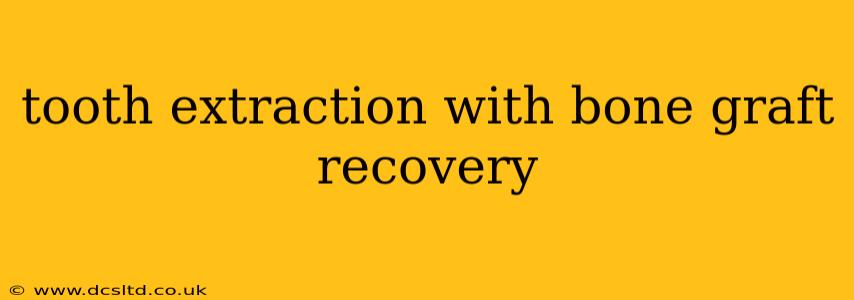Losing a tooth is never easy, but modern dentistry offers solutions like bone grafting to improve the chances of successful implant placement later. This comprehensive guide will walk you through the recovery process after a tooth extraction with a bone graft, answering common questions and providing valuable tips for a smoother healing experience.
What is a Bone Graft After Tooth Extraction?
A bone graft is a surgical procedure where bone tissue is added to your jawbone. This is often necessary after tooth extraction, especially if significant bone loss has occurred. The missing bone is replaced with bone from another part of your body (autograft), a donor (allograft), or synthetic bone material (xenograft or alloplast). The purpose is to rebuild the jawbone's structure and volume, creating a stable foundation for dental implants or to prevent further bone loss. The specific type of bone graft used depends on the extent of bone loss and your overall health.
How Long Does it Take to Recover from a Tooth Extraction with a Bone Graft?
Recovery time varies considerably depending on several factors, including the complexity of the surgery, the type of bone graft used, and individual patient healing rates. Generally, expect initial discomfort and swelling for the first few days. Full healing can take several months, even up to a year, before the bone graft is fully integrated.
What are the Stages of Recovery After a Tooth Extraction with Bone Graft?
The recovery process is usually divided into several distinct stages:
Immediate Post-Operative Period (Days 1-7):
- Pain and Swelling: Expect some pain and swelling in the extraction site. Your dentist or oral surgeon will prescribe pain medication to manage discomfort. Apply ice packs to reduce swelling.
- Bleeding: Some bleeding is normal, but excessive bleeding should be reported immediately to your dentist.
- Diet: Stick to a soft, liquid diet during this initial phase. Avoid hot foods and drinks.
- Oral Hygiene: Gentle rinsing with saltwater can help keep the area clean, but avoid forceful rinsing or brushing near the extraction site.
- Rest: Get plenty of rest to aid in healing.
Week 2-4:
- Decreased Pain and Swelling: Pain and swelling should gradually subside.
- Improved Diet: You can gradually transition to softer foods and slowly reintroduce more solid foods as tolerated.
- Sutures Removal (if applicable): Your dentist might remove any sutures.
- Regular Checkups: Attend your scheduled follow-up appointments with your dentist.
Months 4-6 and Beyond:
- Bone Graft Integration: The bone graft will gradually integrate with your existing jawbone.
- Implant Placement (if applicable): Once the bone graft has healed sufficiently, dental implants can be placed.
- Complete Healing: Full healing can take several months, even up to a year, depending on individual factors.
What are the Potential Risks and Complications of Bone Grafting?
While bone grafting is generally safe, potential risks and complications include:
- Infection: Infection at the surgical site is a possibility, although rare with proper aftercare.
- Nerve damage: Damage to nearby nerves can occur, potentially leading to numbness or tingling.
- Sinus communication: If the extraction site is near the sinus cavity, a communication between the mouth and sinus can develop.
- Graft rejection: While rare, the body may reject the grafted bone material.
- Delayed healing: Healing might take longer than expected in some cases.
How Can I Manage Pain and Swelling After a Bone Graft?
Pain and swelling are normal after a bone graft. Your dentist will prescribe pain medication to manage discomfort. Follow these tips to help manage pain and swelling:
- Ice packs: Apply ice packs to the affected area for 15-20 minutes at a time, several times a day.
- Elevation: Keep your head elevated while resting.
- Soft foods: Stick to a soft diet to avoid irritating the surgical site.
- Rest: Get plenty of rest to promote healing.
- Anti-inflammatory medications: Nonsteroidal anti-inflammatory drugs (NSAIDs) like ibuprofen may help reduce swelling and pain. Always follow your dentist’s instructions.
What Should I Avoid After a Tooth Extraction with Bone Graft?
To ensure optimal healing, it's crucial to avoid certain things after your procedure:
- Smoking: Smoking significantly impairs healing and increases the risk of complications.
- Alcohol: Avoid alcohol consumption as it can thin the blood and increase bleeding.
- Strenuous activity: Avoid strenuous exercise or physical activity for several days to avoid disrupting the healing process.
- Hot foods and drinks: These can increase swelling and discomfort.
- Using a straw: Sucking through a straw can dislodge the blood clot and impair healing.
When Should I Call My Dentist?
You should contact your dentist immediately if you experience:
- Excessive bleeding: Bleeding that doesn't stop after several hours.
- Severe pain: Pain that is not controlled by medication.
- Increased swelling: Swelling that worsens or spreads beyond the extraction site.
- High fever: A temperature above 101°F (38.3°C).
- Signs of infection: Pus, redness, or increased pain.
- Numbness or tingling: Persistent numbness or tingling in your mouth or jaw.
This information is for general guidance only and does not substitute professional dental advice. Always consult your dentist or oral surgeon for personalized recommendations and care specific to your individual circumstances. They can best assess your progress and address any concerns you may have throughout your recovery.
